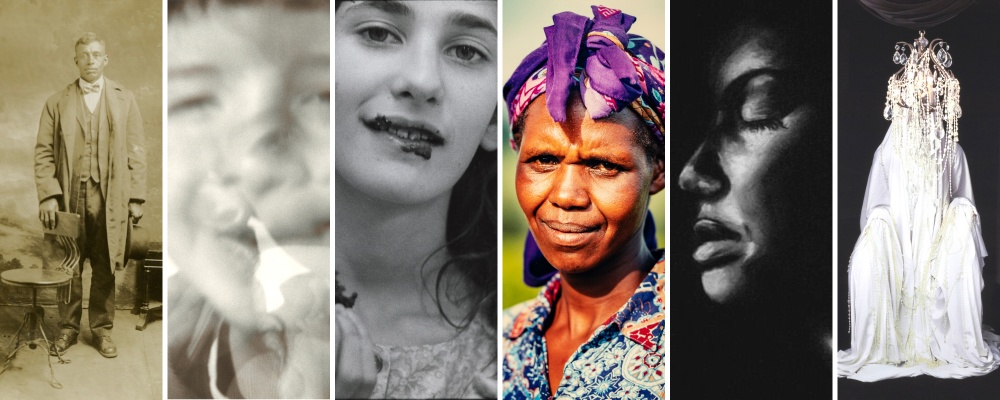Blog
Portraiture: Cartes-de-visites to Selfies
September 01, 2022

Images (left to right): Untitled (Portrait of a Man) (detail), Artist Unknown, real photo postcard, circa 1907. 2020.1.27, Diana Series: Untitled (detail), Claudia S. Liberatore, photograph, 1984. 2019.48.71, Darkside of Morning Series: Untitled (detail), Douglas R. Gilbert, photograph on board, 1965-1966. 2018.48.741, Tea Plucker in Purple (detail), Dan Watts, photograph, 2002.2002.572.1, Reflection (detail), Melissa Campbell, photograph, 2008. 2008.378.1, Chandelier (detail), Patty Carroll, digital archival print. 2021.73.22.
In 1839, Robert Cornelius took the first known photographic portrait
of a human taken in the United States, an image of himself. Soon after
this image was taken, the daguerreotype, named after the French
inventor Louis Jacques Mandé Daguerre, became the first commercially
successful photographic process. The relatively low cost of
daguerreotypes led to a rise in the popularity of portrait photography
over painted portraiture. Capitalizing on the desire for capturing an
individual’s likeness, photographic technology evolved rapidly.
Cartes-de-visites, small photographic portraits printed on
cardboard, soon became popular as they were easy to display and could
be printed on demand. Even less expensive than its photographic
predecessors, having a portrait made was no longer only for the very
rich. The number of photographic studios in Europe and America
exploded, with photographers running businesses in every major city
and traveling with local fairs and carnivals.
This emergence of photography in the early 19th century triggered a shift in the genre of portraiture. The early photographic portraits still followed many of the conventions of the painted portrait. Clothing and surrounding objects continued to indicate a person’s social status. When W.H. Fox Talbot invented a way to reproduce duplicates with a paper negative, the foundations of the modern photographic process were born.
In the late 19th and early 20th centuries, photography was easier than ever. Going beyond the posed portrait, photographic portraits presented subjects posed naturally, even if they were not flattering. The subjects could choose what was in their portrait, including everything from pets to important possessions or places they wanted to remember. The portrait became dynamic and unpredictable, capturing a single moment in a person’s life, either for documentation or strictly for the sake of art.
Today, the portrait takes on various forms, from the traditional to the experimental, from studio portraits to a cellphone selfie. In the end, portraits are always about the interpretation or representation of a person, moment or expression. From painted portraiture to contemporary photography the genre of portraiture includes a multitude of possibilities for creating the likeness of an individual.
Check out these photographic portraits from the GVSU Art Collection...
Tea Plucker in Purple , Dan Watts, photograph, 2002.2002.572.1
Lois Van Woerkom , Faune D. Benson, photograph, 2004. 2005.008.1
Reflection , Melissa Campbell, photograph, 2008. 2008.378.1
Untitled , Ruiyuan Chen, photograph, circa 2009. 2009.123.10
Diana Series: Untitled , Claudia S. Liberatore, photograph, 1984. 2019.48.71
Darkside of Morning Series: Untitled , Douglas R. Gilbert, photograph on board, 1965-1966. 2018.48.741
Untitled (Portrait of an Albino Woman) , Sword’s Brothers, cabinet card. 2019.55.7
Chandelier , Patty Carroll, digital archival print. 2021.73.22
Untitled (Portrait of a Man), Artist Unknown, real photo postcard, circa 1907. 2020.1.27
Untitled (Portrait of a Young Woman) , Artist Unknown, tintype, circa 1894. 2020.1.160
